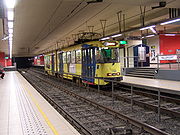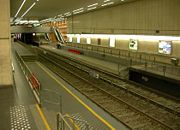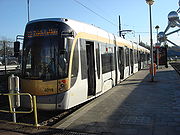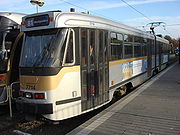
Brussels trams
Encyclopedia

Brussels
Brussels , officially the Brussels Region or Brussels-Capital Region , is the capital of Belgium and the de facto capital of the European Union...
tram
Tram
A tram is a passenger rail vehicle which runs on tracks along public urban streets and also sometimes on separate rights of way. It may also run between cities and/or towns , and/or partially grade separated even in the cities...
(or streetcar) system is one of the ten largest in the world, carrying some 75.6 million passengers in 2009. Its development demonstrates many of the quandaries that face local public transport planners. It also has a number of interesting peculiarities.
History
The first horse-drawn trams were introduced in Brussels in 1869, and ran from the Porte de Namur to the Bois de la Cambre.Intermodal integration
The system exists in an interesting local government context, because Brussels is a self-governing region, in fact an enclave within FlandersFlanders
Flanders is the community of the Flemings but also one of the institutions in Belgium, and a geographical region located in parts of present-day Belgium, France and the Netherlands. "Flanders" can also refer to the northern part of Belgium that contains Brussels, Bruges, Ghent and Antwerp...
, although lying only some 3.3 kilometres from Wallonia at the closest point. This means that three-way deals are necessary between Brussels’ own STIB/MIVB, Flanders’ De Lijn
De Lijn
Vlaamse Vervoersmaatschappij De Lijn , usually known as simply De Lijn , is a company run by the Flemish government in Belgium to provide public transportation, similar to the way in which Belgian railroads or the postal system is run. It runs about 3650 buses and 359 trams...
and Wallonia’s TEC
TEC (transport)
Société Régionale Wallonne du Transport , is responsible for the supervision, strategic planning and marketing of a group of five regional public transport companies branded as TEC or "Transport En Commun" in Wallonia, Belgium. It is primarily a bus operator, but also operates the Charleroi tram...
. Within the range of transport modes operated by STIB/MIVB (the Brussels Intercommunal Transport Company
Brussels Intercommunal Transport Company
The Brussels Intercommunal Transport Company is the local public transport operator in Brussels, Belgium...
) trams fall between bus
Bus
A bus is a road vehicle designed to carry passengers. Buses can have a capacity as high as 300 passengers. The most common type of bus is the single-decker bus, with larger loads carried by double-decker buses and articulated buses, and smaller loads carried by midibuses and minibuses; coaches are...
es and a heavy metro
Rapid transit
A rapid transit, underground, subway, elevated railway, metro or metropolitan railway system is an electric passenger railway in an urban area with a high capacity and frequency, and grade separation from other traffic. Rapid transit systems are typically located either in underground tunnels or on...
. But beyond that, STIB sees itself as a provider of mobility rather than just public transport, and has a 49% share in the town’s Cambio carsharing
Carsharing
Car sharing or Carsharing is a model of car rental where people rent cars for short periods of time, often by the hour. They are attractive to customers who make only occasional use of a vehicle, as well as others who would like occasional access to a vehicle of a different type than they use...
franchise. The Brussels conurbation – its 19 municipalities plus adjoining commuter belt – is also served by a fairly dense network of main-line trains. There is a good level of interticketing, and multiple-journey cards are interchangeable. A simple tariff system permits passengers to make unlimited changes with a one-hour period at a cost of €
Euro
The euro is the official currency of the eurozone: 17 of the 27 member states of the European Union. It is also the currency used by the Institutions of the European Union. The eurozone consists of Austria, Belgium, Cyprus, Estonia, Finland, France, Germany, Greece, Ireland, Italy, Luxembourg,...
2.00 when bought from the driver or €
Euro
The euro is the official currency of the eurozone: 17 of the 27 member states of the European Union. It is also the currency used by the Institutions of the European Union. The eurozone consists of Austria, Belgium, Cyprus, Estonia, Finland, France, Germany, Greece, Ireland, Italy, Luxembourg,...
1.80 when bought from a ticket machine.
Ridership has been rising, and other user-friendly features that have grown up through custom and practice help this. For instance passengers open the doors themselves by pressing a green strip on the central pole, and drivers usually make a point of waiting for latecomers. However overcrowding at rush hours and at weekend is common, and fare-dodging is reputedly quite high, despite periodic enforcement campaigns.
Routes


Reserved track
In tram transport terminology reserved track is track on ground exclusively for trams. Unlike track on streets and roads, reserved track does not need to take into account the transit of other wheeled vehicles, pedestrians, bicyclists or horses...
through parkland and woods (44), and signal-controlled running in tunnels (the premetro). There are even some short stretches of gutter running (18). Almost all trams are double-ended and all are double-sided, and some stub termini remain (4, 51), although most have loops.
The route pattern shows some notable gaps, particularly along major radial routes, because these were originally served by a separate tram system, the national network of buurtspoorwegen/tramways vicinaux
Vicinal tramway
The Tramways vicinaux or Buurtspoorwegen were a system of narrow gauge tramways or local railways in Belgium, which covered the whole country and had a greater route length than the mainline railway system...
. These had a track gauge of one metre, as against the Brussels standard gauge
Standard gauge
The standard gauge is a widely-used track gauge . Approximately 60% of the world's existing railway lines are built to this gauge...
, and so the tracks could not easily be taken over when the lines were progressively closed from the 1960s onwards.
The complementary routing of vicinal and urban tracks and the replacement of key lines by metro has led to some peculiar track layouts, for instance at the Barrière de St-Gilles
Saint-Gilles, Belgium
Saint-Gilles or Sint-Gillis is one of the nineteen municipalities located in the Brussels-Capital Region of Belgium.Saint-Gilles has a multicultural identity stemming from its diverse population...
/Bareel St-Gillis. Of the seven roads that meet at this circular junction, all originally contained tramlines, whereas today only three do. To negotiate a sharp turn, route 18, until it was closed on 1 July 2007, had to make a 270-degree turn on its journey away from the city centre, looping round and crossing its own path.
A further peculiarity is that under the South station, the premetro and metro tracks both swap from running on the right to running on the left where they run parallel to provide cross-platform interchange
Cross-platform interchange
A cross-platform interchange is a type of interchange between different lines in a metro system. The term originates with the London Underground; such layouts exist in other networks but are not commonly so named...
between the two lines. This serves no apparent purpose, but may be because main line trains in Belgium run on the left. Trams cross back to the right under Place Bara but the metro stays on the left as far as the Roi Baudouin terminus.
Between 2006 and 2009 a phased transformation of the tram network took place, with the aim of improving regularity and relieving overcrowding. As part of this the premetro service between North station
Brussels-North railway station
Bruxelles-Nord / Brussel-Noord is one of the three major railway stations in Brussels; the other two are Brussels Central and Brussels South...
and Albert was restructured with fewer lines passing through it, but at more regular intervals. These routes use the new longer Bombardier
Bombardier Transportation
Bombardier Transportation is the rail equipment division of the Canadian firm, Bombardier Inc. Bombardier Transportation is one of the world's largest companies in the rail-equipment manufacturing and servicing industry. Its headquarters are in Berlin, Germany....
trams. The major part of the North-South Axis (from Lemonnier
Lemonnier premetro station
The Lemonnier premetro station is an underground tram station in the City of Brussels, Brussels, Belgium. It is located near the crossroad between the Maurice Lemonnier boulevard and the small ring road. It is part of the North-South Axis tunnel which crosses the city center from the Brussels-North...
to Rogier) is now used only by lines 3 and 4 during the day. These lines have been branded Chrono. Tram lines 55 and 56 from Schaerbeek (north of Brussels) that used to use the North-South Axis now terminate at Rogier and nearby Gare du Nord/Noordstation respectively.
As part of that plan, line 52 has been replaced by line 3 in the North (from the Brussels-South railway station to Thomas and from Van Praet to Esplanade), and by lines 56 (from Rogier to Princess Elisabeth), 82 (from Drogenbos to Lemonnier) and 32 in the South.
An already implemented part of this plan was the creation of tramway lines 24 and 25 in April 2007. Line 25 goes from Rogier to the Boondael/Boondaal railway station following the route of the ex-line 90 from Rogier to Buyl, then leaves the outer ring towards the Université Libre de Bruxelles
Université Libre de Bruxelles
The Université libre de Bruxelles is a French-speaking university in Brussels, Belgium. It has 21,000 students, 29% of whom come from abroad, and an equally cosmopolitan staff.-Name:...
campus of Solbosch. The (somewhat older) new line 24 strengthens the tram presence on the outer ring during daytime; it went from the Schaerbeek/Schaarbeek railway station
Schaarbeek railway station
Schaerbeek - Schaarbeek is a railway station in the municipality of Schaerbeek, Brussels-Capital Region, Belgium.Located to the north-east of the centre of Brussels, the station mainly serves trains travelling between central Brussels and Leuven, Antwerp or Brussels National Airport.On these routes...
to Vanderkindere in Uccle
Uccle
Uccle or Ukkel is one of the nineteen municipalities located in the Brussels-Capital Region of Belgium.Uccle is known for its well-to-do areas, its green spots and its high rental rates.-History:...
.
On March 14, 2011 lines 24 and 23 merged to create the new eastern semicircular line 7 running almost entirely on its own right of way. The new service runs from Heizel/Heysel
Heysel
Heysel or Heizel , is an area in Brussels and may in particular refer to:* Heysel Park, a part of Brussels* Heysel Metro Station, one of the metro stations on line 6 of the Brussels Metro...
in the north to Vanderkindere in the south.
High-floor and low-floor trams

Low-floor tram
A low-floor tram is a tram that has no stair steps between one or more entrances and part or all of the passenger cabin. The low-floor design improves the accessibility of the tram for the public, and also may provide larger windows and more airspace....
street-running trams and high-floor underground railway. This has led to some conflicting decisions. The standard trams – still "PCC
PCC streetcar
The PCC streetcar design was first built in the United States in the 1930s. The design proved successful in its native country, and after World War II was licensed for use elsewhere in the world...
"s from the 1950s and 60s – have been followed by the specially designed "T2000" low-floor model, and at the end of 2005 was joined by a variant of the off-the-shelf "Flexity Outlook
Flexity Outlook
The Flexity Outlook is a family of 100% low-floor articulated light-rail trams manufactured by Bombardier Transportation. Part of the larger Flexity product line , Flexity Outlook cars fall into two distinct sub-categories with dramatically different appearances...
" from Bombardier
Bombardier Transportation
Bombardier Transportation is the rail equipment division of the Canadian firm, Bombardier Inc. Bombardier Transportation is one of the world's largest companies in the rail-equipment manufacturing and servicing industry. Its headquarters are in Berlin, Germany....
(3000 series), and end of 2006 by an even longer version of the same family (4000 series). When the current order of 87 vehicles is fulfilled in 2012, Brussels expects to have the world's largest fleet of low-floor trams.
However on some of the busiest routes the convenience of the low floor is lost because of the anomalies caused by the hesitant upgrade of tram to metro. The city now has four heavy metro lines and three stretches of premetro or underground tram. The premetro tunnels have been built to allow for eventual upgrade to heavy metro. Thus most of the platform is high, and is connected to the street (at least in the upward direction) by escalator. At some stations lifts have been installed. But there is a cutout section taking the level down to one foot above ground, to board the trams. The three steps this entails make life difficult for passenger with baby buggies or suitcases, even though the new low-floor trams themselves are accessible to wheel-chair users. To get round this last barrier to mobility, an experimental ramp was installed in 2009 at Parvis de St-Gilles/St-Gillis Voorplein.
Rolling Stock
As of July 2010, STIB operates the following trams, stabled in five depots:| Tramcar Type | Depot Allocations | Count |
|---|---|---|
| PCC 7700/7800 | All | 128 |
| PCC 7900 | ? | 61 |
| Bombardier T2000 | Ixelles, Schaerbeek | 51 |
| Bombardier T3000 | ? | 151 |
| Bombardier T4000 | ? | 35 |
| Total | 326 |
Livery

A profound change in livery came in 2006 with the adoption of the so-called art nouveau
Art Nouveau
Art Nouveau is an international philosophy and style of art, architecture and applied art—especially the decorative arts—that were most popular during 1890–1910. The name "Art Nouveau" is French for "new art"...
livery, of silver and light brown, which adorns the new 3000 and 4000 vehicles and is gradually being applied to the whole fleet.
2010 Vancouver Olympics
From January 21 to March 21, 2010, a demonstration streetcar project, known as the Olympic Line, at Vancouver, BC, CanadaCanada
Canada is a North American country consisting of ten provinces and three territories. Located in the northern part of the continent, it extends from the Atlantic Ocean in the east to the Pacific Ocean in the west, and northward into the Arctic Ocean...
, utilised Brussels cars 3050 & 3051 (Bombardier
Bombardier Transportation
Bombardier Transportation is the rail equipment division of the Canadian firm, Bombardier Inc. Bombardier Transportation is one of the world's largest companies in the rail-equipment manufacturing and servicing industry. Its headquarters are in Berlin, Germany....
Flexity Outlook
Flexity Outlook
The Flexity Outlook is a family of 100% low-floor articulated light-rail trams manufactured by Bombardier Transportation. Part of the larger Flexity product line , Flexity Outlook cars fall into two distinct sub-categories with dramatically different appearances...
) on a Vancouver Downtown Historic Railway
Vancouver Downtown Historic Railway
The Vancouver Downtown Historic Railway is a heritage streetcar line that operates between Granville Island and the Cambie Station in Vancouver, British Columbia, Canada. It operates only on weekends and holidays, usually from May to mid-October, and is aimed primarily at tourists...
1.8 km track. http://olympichostcity.vancouver.ca/pdf/factsheet-streetcar-march25.pdf
Heritage trams
The system exists in happy symbiosisSymbiosis
Symbiosis is close and often long-term interaction between different biological species. In 1877 Bennett used the word symbiosis to describe the mutualistic relationship in lichens...
with an active heritage operation
Heritage railway
thumb|right|the Historical [[Khyber train safari|Khyber Railway]] goes through the [[Khyber Pass]], [[Pakistan]]A heritage railway , preserved railway , tourist railway , or tourist railroad is a railway that is run as a tourist attraction, in some cases by volunteers, and...
based at the Woluwe
Woluwe
The Woluwe is a stream that goes through several municipalities in the southeast and east of Brussels and is a right tributary of the Senne/Zenne . The Kleine Maalbeek is a tributary of the Woluwe . Many ponds formed along the stream over time, among which the Mellaerts Ponds still exist...
depot, and privately hired trams have free access to the tracks. Very old trams, which still collect their current through trolley pole
Trolley pole
A trolley pole is a tapered cylindrical pole of wood or metal, used to transfer electricity from a "live" overhead wire to the control and propulsion equipment of a tram or trolley bus. The use of overhead wire in a system of current collection is reputed to be the 1880 invention of Frank J....
s rather than pantographs
Pantograph (rail)
A pantograph for rail lines is a hinged electric-rod device that collects electric current from overhead lines for electric trains or trams. The pantograph typically connects to a one-wire line, with the track acting as the ground wire...
, are normally restricted to the scenic line from Cinquantenaire
Cinquantenaire
Parc du Cinquantenaire or Jubelpark is a large public, urban park in the easternmost part of the European Quarter in Brussels, Belgium....
park via Woluwe to Tervuren
Tervuren
Tervuren is a municipality in the province of Flemish Brabant, in Flanders, one of the three regions of Belgium. The municipality comprises the villages of Duisburg, Tervuren, Vossem and Moorsel. On January 1, 2006, Tervuren had a total population of 20,636...
, which is run with the help of volunteers from the preservation society MTUB (Museum of Brussels Urban Transport). This service runs at weekends from April to October; occasionally, such as on the Belgian national holiday July 21, these trams appear in the city centre, where the line in the "Koningsstraat/Rue Royale" is trolleypole-enabled.
Over the years, several Brussels trams have been sent to the United States
United States
The United States of America is a federal constitutional republic comprising fifty states and a federal district...
. Brussels tram 7037 is in San Francisco
San Francisco, California
San Francisco , officially the City and County of San Francisco, is the financial, cultural, and transportation center of the San Francisco Bay Area, a region of 7.15 million people which includes San Jose and Oakland...
operating on line F
F Market
The F Market & Wharves line is one of several light rail lines in San Francisco, California. Unlike the other lines, the F line is operated as a heritage streetcar service, using exclusively historic equipment both from San Francisco's retired fleet as well as from cities around the world...
, surreally repainted in the blue-and-white livery of Zürich
ZVV
The ZVV is a public transportation network system, combining rail, bus, tram, trolleybus, lake boat and cable car services in the canton of Zürich as well as Rapperswil-Jona and Pfäffikon SZ.- History and network :Established in May 1990, it...
. Brussels tram 1504 is at the Trolley Museum of New York and 1511 is at Old Pueblo Trolley
Old Pueblo Trolley
The Old Pueblo Trolley is a heritage streetcar system operating in Tucson in the U.S. state of Arizona.Service is provided Friday evenings, Saturday afternoons and evenings, and Sunday afternoons on over a mile of line recovered from Tucson's original street railway...
. An ex-Brussels 4-axle PCC is also awaiting restoration at the Ontario St shed of Vancouver's Downtown Historic Railway
Vancouver Downtown Historic Railway
The Vancouver Downtown Historic Railway is a heritage streetcar line that operates between Granville Island and the Cambie Station in Vancouver, British Columbia, Canada. It operates only on weekends and holidays, usually from May to mid-October, and is aimed primarily at tourists...
.
Route list
Tram routes as of 17 November 2011:- 3: Esplanade — Churchill
- 4: Stalle P — Gare du Nord / Noordstation
- 7: Heysel / Heizel — Vanderkindere
- 19: De Wand — Groot-BijgaardenGroot-BijgaardenGroot-Bijgaarden is a village and deelgemeente of Dilbeek.-Toponomy:The name Bijgaarden is derived from the Germanic word for enclosure. The appellation "Great" was attached to distinguish it from the smaller Klein-Bijgaarden nearby, now in the municipality of Sint-Pieters-Leeuw.-History:The...
- 25: Boondael railway stationBoondael railway stationThe Boondael railway station in Ixelles, Belgium is a SNCB railway station in Brussels. The station is a stop for local trains running on the routes Vilvoorde - Halle, Mechelen - Halle , Mechelen - Geraardsbergen and Aalst - Braine-l'Alleud...
— Rogier - 31: Gare du Nord / Noordstation — Marius Renard Only in the evening.
- 32: Drogenbos Château / Drogenbos Kasteel — Da Vinci Only in the evening.
- 39: Ban Eik — Montgomery
- 44: Montgomery — Tervuren Station
- 51: Heysel / Heizel — Van Haelen
- 55: Da Vinci — Rogier
- 62: Da Vinci - Weldoeners/Bienfaiteurs
- 81: Marius Renard — Montgomery No service in the evening.
- 82: Berchem StationBerchem-Sainte-Agathe railway stationThe Berchem-Sainte-Agathe railway station is a railway station in the municipality of Berchem-Sainte-Agathe in Brussels, Belgium. The station operated by the SNCB/NMBS is located on the line 50, which connects the Brussels-North railway station to the Gent-Sint-Pieters railway station between the...
— Drogenbos Château / Drogenbos Kasteel No service in the evening. - 83: Berchem StationBerchem-Sainte-Agathe railway stationThe Berchem-Sainte-Agathe railway station is a railway station in the municipality of Berchem-Sainte-Agathe in Brussels, Belgium. The station operated by the SNCB/NMBS is located on the line 50, which connects the Brussels-North railway station to the Gent-Sint-Pieters railway station between the...
— Montgomery Only in the evening. - 92: Fort-Jaco — Schaerbeek Gare / Schaarbeek Station
- 94: Musée du tram / Trammuseum - Stade / StadionKing Baudouin StadiumThe King Baudouin Stadium is a sports ground in north-west Brussels, Belgium. It was inaugurated on 23 August 1930 as the Stade du Jubilé or Jubelstadion in the presence of Prince Leopold. It was built to embellish the Heysel plateau in view of the Brussels International Exposition...
Only in the evening. 94: Musée du tram/ Trammuseum — Louise / Louiza No service in the evening.94: Legrand — Stade / StadionKing Baudouin StadiumThe King Baudouin Stadium is a sports ground in north-west Brussels, Belgium. It was inaugurated on 23 August 1930 as the Stade du Jubilé or Jubelstadion in the presence of Prince Leopold. It was built to embellish the Heysel plateau in view of the Brussels International Exposition...
No service in the evening.- 97: Louise / Louiza — Dieweg
Stricken-out numbers represent partial services (they don't go up to the end of the line). Only regular services are shown in this list.
Statistics (2009)
Passenger journeys: 76.3 million per yearVehicle-kilometres travelled: 11.7m
Commercial speed: 16.8 km/h
No of trams: 332, of which 21.7% accessible
Length of tramline (double): 133.9 km, of which 72.5 km on reservation and 12.1 km in tunnel
Distance between stops (surface): 392 m
No. of depots: 6, + 2 workshops
Source: STIB/MIVB 2009 annual report

